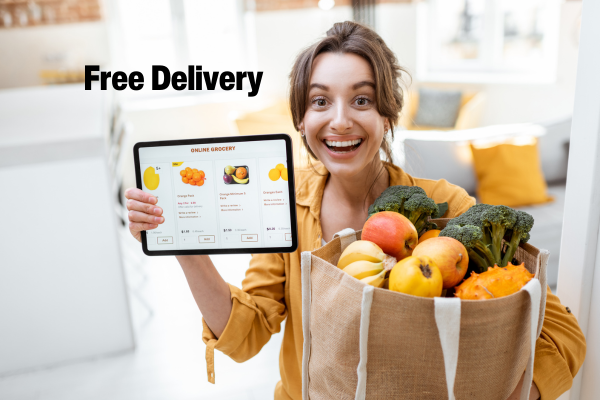Part II
Healthy eating can be simple and easy but doing so involves bucking our current food system.
Now it’s time to look at solutions :)
This is how I follow Michael Pollan’s brilliant advice of “Eat Food, Not Too Much, Mostly Plants” (from his book In Defence of Food, an Eater’s Manifesto)
Let me break down each one of his statements and show you how I ignore Big Food and their food tyranny every day.
Eat Food
In a food system where processed food is subsidized and produce is very expensive, how the heck can you eat a healthy diet without breaking the bank?
These are ways that I make healthy eating more affordable, but it should be said, that even with these tips, it might still be out of budget for many of you.
Collectively, this is something that we need to fight, we need to demand that this changes. Healthy food should be more affordable than processed food because it takes less work!! Broccoli is grown in the ground, picked, and shipped. There’s no doubt that it’s quite labour intensive, but so is growing a commodity grain like corn!
Corn is grown and then refined and processed to make a whole host of ingredients, which are combined with other processed ingredients to make any one of those foods that line the shelves at your grocery store. That’s an incredibly labour-intensive process!! So how the heck does it cost less to buy a package of cookies than broccoli??? Our government programs fund the food processors, that’s how.
But, we have more power to change this than we think. We vote with our dollar every time we shop, and we can petition grocery stores to donate excess produce to food banks and demand our government begin to subsidize whole food over commodity grains, like wheat, corn, and soy.
Here are some ways that I eat loads of whole food on a budget (a budget with a bit of wiggle room).
Focus on Adding
Dieting culture gives us list after list of “bad” foods we shouldn’t eat. This list changes constantly and healthy food confusion is at an all-time high.
But, it’s more than just annoying and confusing, I’d argue that there’s something sinister about these “bad” food lists. When you remove food from your diet (say, sugar, processed food, or gluten), you’re left with a big, gaping hole in your diet. That hole can be really hard to fill, and the food producers have happily created a ton of food products with wildly high profit margins to fill those gaps. (Insanely expensive low-carb keto waffles anyone?).
These products can break any food budget and they’re only temporary solutions. Eventually, that big gaping hole will scream for attention and, frequently, the old food just finds its way back into your diet.
This is where the power of adding comes in. By adding healthy food first, you squish out the less desirable food without really noticing. It lets you look at the food you eat from the view of abundance instead of scarcity. No holes, just lots and lots of different food to choose from.
Instead of counting calories or managing macros, focus on adding just one more serving of produce each day. Over time this can make a huge difference! Add two or three and you’re really rocking!
Experiment with Beans
The whole food that we eat the least is beans. Sometimes it’s because they’re “musical” (they cause a lot of gas), other times they can be intimidating or something that you’re just not in the habit of cooking.
They’re also nutrient superstars! Full of gut bacteria loving fibre, B vitamins, slow-burning carbs, and protein. Once you get in the habit of eating them, you will crave them…it always happens :). And, they’re really cheap to buy! (especially dried beans)
If they cause gas, there are ways to remedy that. The reason they create gas is that your gut bacteria isn’t used to digesting them yet. The more you eat them the less gassy they’ll be. In the meantime, either soak your beans before cooking them in some apple cider vinegar, use a pressure cooker to cook them (like an Instant Pot), or take a digestive enzyme to help break down that fibre (Beano works well and so does many enzymes at your health food store).
If you’re nervous to add beans to your diet, first start with hummus. It’s DELICIOUS, makes for a great snack (or sandwich addition), and you can find ready-made hummus at most grocery stores. It’s easy to make it from scratch too…but honestly, I tend to buy mine.
Next, make a nice chili with canned beans. Notice how delicious and satisfying a big bowl of beans can be. I’ve got a great chili recipe on my website and there are a ton to choose from online.
Then, once you’re feeling beanerific, check out some vegan recipes. They’re chock-full of beans and there are some YUMMY recipes out there. Oh She Glows, Minimalist Baker, and Rainbow Plant Life are some of my favourite sites.
Not Too Much
This is a tricky one, especially nowadays…but there are a few easy ways to trick your brain into eating the portion of food your body actually wants to eat and not the larger portion that food manufacturers are trying to trick you into eating.
First, we can use the concept of “size illusion” for us instead of against us. Size illusion is a well-studied concept that has found that our eyes and brain play a huge role in how full we feel after eating. In a nutshell, if we believe that we ate a lot of food then we’ll feel more satisfied than if we feel we had a tiny portion. The actual portion doesn’t matter as much as how we felt about it.
There have been many many MANY studies that have shown that the size of your food container (plate, bowl, package) determines how much you’ll eat to feel satisfied. Eating out of a larger bag or off of a larger plate can increase your serving size by 30% - 70% without you noticing or feeling overly full. This is true even if it’s food that’s almost inedible (like in the popcorn study below). I find this research fascinating!
Here are some studies if you’d like to learn more:
Terrible popcorn study: https://news.cornell.edu/stories/2005/11/big-portions-influence-overeating-much-taste-even-when-food-tastes-lousy-cornell
Refilling bowl study: https://pubmed.ncbi.nlm.nih.gov/15761167/
How filling we think a food will be also plays a role in how satiated we feel after eating. It even affects our hunger hormones! In this study, people were given two different milkshakes, one was listed as low-cal and “diet” and the other was an “indulgent” shake.
Blood work was done after they consumed each one and the hunger hormone ghrelin steeply fell with the indulgent shake, showing that they were more satisfied at a hormonal level. The kicker was…they were exactly the same shake.
Same shake, different reaction because they were told one was higher calorie than the other. This means that our brain plays a big role in how satisfied we feel after eating and that “diet” foods can keep you hungrier just because of their label!
So, let’s use this “size illusion” concept for good instead of evil! This is something I practice every day and it works really well.
Plate size: I rarely, if ever, eat off of a full-sized plate. Instead, especially for dinner, I grab a side plate and fill it to my heart’s content. I leave the kitchen knowing I can get seconds if I’m still hungry, but so far, that’s never happened. My plate feels full and I end the meal feeling very satisfied :).
Always fill your own plate: Don’t let your partner or another family member fill your plate for you. There’s a good chance they’ll give you more food than you want, and as we’ve seen, it’s hard to stop when your eyes say this is the right portion. The exception to this rule is if you’re underweight and need to put on a few extra pounds – in that case having someone else fill your plate works like a charm to gain weight.
Don’t eat out of the container: The best way to eat a HUGE snack, many times bigger than what your body wants, is to eat out of the container. It’s even worse is if there’s another person sharing the bag with you.
My snack container is a ramekin, it seems almost laughably small, but it’s usually exactly the right amount. If I’m still munchy after I finish, I just get more. Even two servings in a ramekin are less than one big bowl. I use this for chips, crackers, nuts, seeds, etc. I use a regular bowl for popcorn and veggies.
These ideas may seem too simple to work, but that’s the magic of it. They’re so simple that they DO work! You feel like you’re eating an abundance of food and your body responds in kind. As the research shows, if you feel like you’ve eaten enough then your hunger hormones drop. If you feel like your meal is too small, from counting the calories, eating something labeled “diet”, or if there’s a lot of empty space on your plate, then your hormones will keep you hungry.
Use size illusion for the good! Smaller plates and bowls for the win!
Mostly Plants
Eating more plants can be hard in our convenience food life…mostly because they’re inconvenient. Here are some tricks that I use to increase the plants in my life.
Add plant-based snacks
Before reaching for cookies, crackers, pretzels, or other yummy snack foods, I grab a piece of fruit first. Or some carrots and hummus. I don’t deny myself those other snack foods, I just start with something plant-based and if I’m still munchy then I grab something else. This calms my appetite before reaching for the more processed snack, helping me eat less :)
Another way I increase my plant-based snacks is by making healthy cookies and brownies. My tahini cookies and my black bean brownie recipes are household favourites and I can barely tell that I’m actually eating something that’s chockfull of nutrients and plant-based fibre.
Eat Seasonally
Your body and your wallet will enjoy this. It’s only been a handful of decades that have allowed us access to all types of produce throughout the year. But, your body isn’t always a fan. Eating a salad in January is hard on the body, it’s expensive…and it can also trigger sugar cravings in an attempt to warm your body back up after that cold, cold salad.
By shifting your food purchases to match the season, you save a lot of money and you might find your cravings are less as well.
What this looks like in a cooler climate (like Canada and northern US):
Summer – cooling, fast growing produce, like; salad greens, tomatoes, cucumbers, berries, stone fruit, etc.
Fall – transition time, beginning of warming foods, like; end of season tomatoes, carrots, beets, onions, garlic, apples, pears, squash, and dark leafy greens like chard and kale.
Winter – food that can be stored easily, like; potatoes, sweet potatoes, carrots, beets, squash, apples, pears.
Spring – transition time, adding some cooler foods, like; end of season winter vegetables mixed with spring veggies like; asparagus, sprouts, spring greens, and berries.
In-season produce is a fraction of the price and has SO MUCH more flavour. One of my favourite things to do in October is to hit up a few produce stands and farmer’s markets and buy bulk squash and root veggies.
They’re usually on a mega sale (about ¼ of their usual price) and winter squash stores all winter long at room temperature. I decorate my house with the squash (they’re very pretty :) and I try to use them up before spring. But a warning; winter squash seems to know the moment the weather warms up and within a week they all start to rot (and can leave unfortunate marks on my tables if I don’t catch them in time). Be sure to use them up or find some fridge space before the spring sun gets too strong!
These are some of the ways that I eat in a simple, healthy way. And, I think the most important tool for my healthy lifestyle is my mindset – I’m not striving for perfection, I’m striving for pretty good.
Pretty good is all you need for your body to be healthy. You don’t need to give up processed food forever, just keep it as an occasional treat or helping hand. Every day I strive to eat about 80% of my diet or so to be filled with whole foods. That feels doable to me today, but that’s not where I started.
At the beginning of my healthy eating journey, I rarely ate any veggies or fruit. Beans were unheard of in my diet, and the only nuts were sugar-sweetened peanut butter. I felt terrible and I didn’t know that my diet had something to do with how I felt.
I started by adding whole foods, one at a time. First, I tried to have one fruit or veggie every day. Immediately I felt better and started to crave them. Slowly over time I got to the place where 80% is easy and I crave healthy food if I haven’t been eating enough.
My best advice for you right now is this – start where you are, try a technique or two, and remember to ignore commercials and the “healthy” promises of processed food Look to add more whole foods to your diet, and slowly and surely wins every time ❤️






